Lasang Pinoy: Odd Cuts and Guts
Lasang Pinoy, or “Filipino Taste,” is a monthly food blog event to promote Filipino food and Filipino cooking. There are hundreds of Filipinos on the Web who celebrate Filipino culture through cooking, and I hosted April 2006’s Lasang Pinoy, which I’ve given the title of Lamang-loob: Odd Cuts and Guts. In Tagalog, laman [la’man] translates to “contents,” and loob [lo’ob] means inside–I want to feature the contents inside of an animal, or what is commonly referred to as offal.
Using the “waste” parts of a butchered animal has always been part of the human diet. The nobility during the Middle Ages placed a great deal of significance on eating an animal’s heart, liver, kidneys and intestines. Peasants dined on “lesser” cuts of meat because of economic necessity. Farmers and butchers raised animals and sold the meat to the markets to make money; most of the time, they were left with the odd cuts and guts to survive. Growing up in the Philippines, our parents told us that offal protected us from being ill, and whenever my non-Filipino friends travel back home with me, my relatives tell them that offal’s good for “many children.”
If you’re familiar with Filipino cooking, you’ve probably heard of dinuguan, or pig’s blood stew. A tamer version of this dish, which is also what my father cooks at home, is made of diced pork. I once tasted a version made out of all the offal of the pig we were roasting on a spit for twelve hours. Needless to say, it was the most bitter–and funny-smelling–dish I’ve ever tasted.
Offal doesn’t have to taste or smell funny. When cooked right–and I mean cooked right, not cooked through–offal can be delicate and savory. When I was planning my first visit to London, I made sure I got restaurant reservations at St. John’s before I bought my plane tickets. Chef Fergus Henderson’s nose-to-tail motto marks him as one of the most innovative yet traditional chefs out there, praised by Kitchen Confidential‘s Anthony Bourdain. He has used the phrase “religious epiphany” when describing Henderson’s cooking.
I like offal, and I’m not at all squeamish when it comes to trying something new in a restaurant. My motto when it comes to eating has always been, If I don’t try it, how would I know I won’t like it? So I try. I don’t exactly remember the first time I had sweetbreads but I do know that whenever they’re on the menu, I can’t pass them up. Foie gras, minus the hoopla behind it, seems a more acceptable item to see on a menu. I had no problem spending 50€ each for two jars of foie gras to bring back from Paris.
Two of my favorite chefs, Mario Batali and Fergus Henderson, both use offal in their recipes. My first time at New York City’s Babbo was memorable because of the beef cheek ravioli with squab liver, a staple on the restaurant’s menu. I visit Babbo once a year because of that dish. In London, the pig’s ears terrine was one of the most beautifully presented dishes I’ve seen. Chef Henderson’s roasted bone marrow is one of his most popular. Reproducing it was a cinch. At The Spotted Pig, a gastro-pub in New York frequented by trendsetters and foodies alike, they serve lamb’s tongue and veal kidneys. It’s not a surprise that Chef Batali is also one of the great minds behind it.
One challenge I posed to participants of the 9th Lasang Pinoy was to break out from the norm. I wanted them to use new ingredients with the offal, while trying to keep the Filipino essence intact by using traditional cooking techniques they learned from childhood memories and family recipes. I must say though, that cooking offal in my kitchen was far different from ordering it from a restaurant. The smell was so strong when I boiled tripe with a veal’s foot that I couldn’t stay in the kitchen and hang out. Part of the continuing challenge of Filipino cooking is to make the dishes appetizing, not just for fellow Filipinos, but for everyone we cook for.
After a month, here are the contributions from all over the world:
Shalimar calls Athens, Greece home but is currently on a boat (!) in the south of France. She had to pay 3€ per hour to submit her bastardized dinuguan from an Internet café. She used blood sausages and Frenchified it.
Chinese-Filipino Mei Mien played with tripe–a brave soul considering this is her first Lasang Pinoy contribution–and mixed it with oxtail to make a very hearty kare-kare. I think the bok choy in this balances out the texture of the tripe and the richness of the oxtails.
And how can Iska skip this one? All the way from Beijing, she cooked chicken livers, bistek style. I wonder what she can come up with if she had more “time”? How can any true Filipino say no to soy sauce with calamansi juice with this dish?
JMom of North Carolina also used chicken livers in her adobo but she included the gizzards. Mmm, imagine that over hot fried rice…
Celia cooked a better-looking lengua estofado than I did. We both had the Filipino humor about the tongue, though! She recreated this dish in the U.K. from a wedding banquet memory from childhood.
Angelo from Sasaktchewan, Canada made a kilawin of tripe with lemon and ginger vinaigrette. It looked perfect for spring! I just wanted to get some pork rinds and a beer after reading about it.
Kai must have read my mind when I wished someone would think of seafood for this round. Not forgetting that fish have innards, too, Kai made a very comforting sinigang using every part of the milkfish except the gills. True Pangasinenses indeed.
Iska struck again and used the small yield of a grouper’s liver with its roe as an appetizer. Ah, the poor man’s caviar.
And some stuck with showing their French skills. I hope that someday, Mickey will create a Filipino recipe using sweetbreads for all of us to see. Other contributions, submitted in Filipino time of course, were the ox tongue with mushrooms, chicken liver Hawaiian-style, pork liver, bopis and arroz caldo with tripe. I know that this 9th round was a challenge, so I thank those who cooked the odd cuts and guts.
And what did the host of Lasang Pinoy: Lamang-loob contribute, you ask?
Callos, Tripe Stew with Blood Sausage
Lengua, Veal Tongue Stew
Bopis, Pig’s Heart Sauté
Lessons I learned throughout this round of Lasang Pinoy:
1. I should have browned the tripe first for an added crisp.
2. Next time, I will try to make callos without the blood sausages, but I will definitely include the Spanish chorizo every time.
3. I added lemon juice in each callo serving so that the offal smell wasn’t too overwhelming.
4. It was very good that I split the entire process for making the callos in three days. There is light at the end of the tunnel.
5. An animal’s tongue will always look like that. Don’t let it scare you.
6. It’s better to overcook the tongue than undercook it.
7. If your Filipino father is too picky to even taste your cooking, I can guarantee you he will eat all three dishes. Mine did and no one’s more maarte than him.
8. Did I already mention that bopis is excellent with ice-cold beer?
Related post/s:
Lasang Pinoy main site
Babbo
The Spotted Pig
Where to get odd cuts and guts
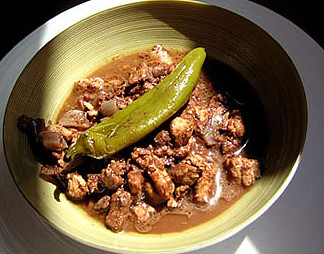
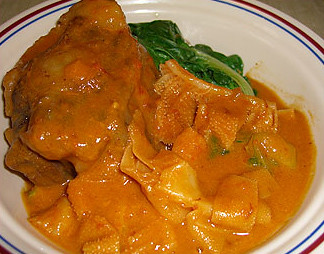
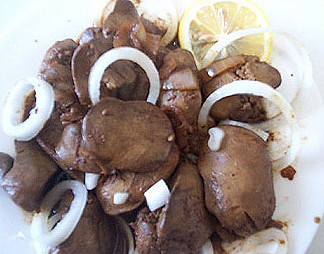


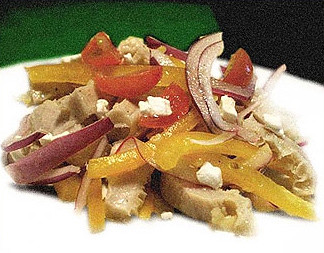
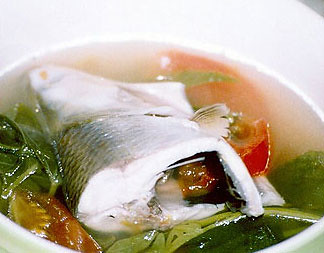
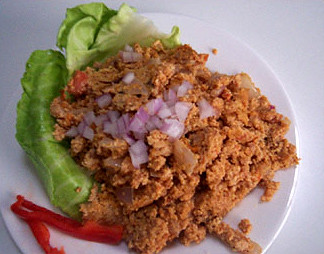
Although I have tasted a lot of foreign dishes, nothing beats Filipino food. Organ meats taste really great, I love it when my mom tries to cook “bistek†using chicken liver and gizzard. I like it so much I even try to learn how to cook it and it was successful I guess, as for my mother’s judgment. I really enjoy eating organ meats, I take advantage of it while I’m still young. I might loose the chance when I already get aged.